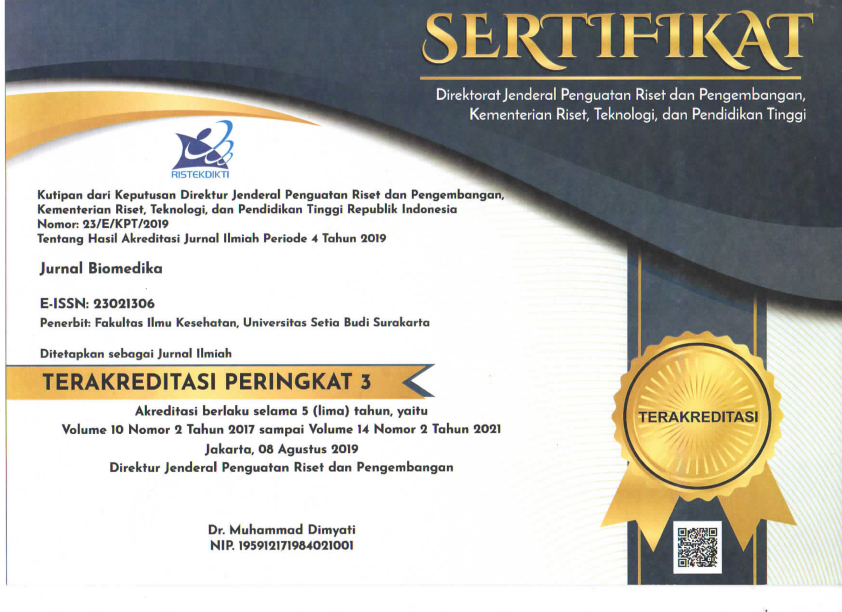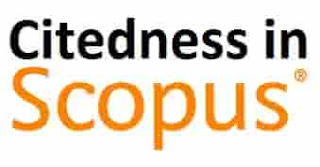Cytotoxicity Assay of Chitosan-Collagen Wound Dressing using Brine Shrimp Lethality Test Methods
Abstract
Wound dressing has a function to protect the wound area from external exposure and provide a moist state around the wound area for accelerating wound healing process. Collagen and chitosan are known as appropriate biomaterials to synthesise of wound dressing because they have anti-bacterial, anti-fungal, biodegradable and biocompatible properties. One of biocompatibility assay for a material is cytotoxicity assay using Brine Shrimp Lethality Test (BSLT) that could be applied before in Vivo assay. The aim of the research was to know the cytotoxicity level of collagen-chitosan wound dressing with variance of concentration such as K0 as control used pure chitosan, K1 used collagen 25% and chitosan 75%, K2 used collagen 50% and chitosan 50%, K3 used collagen 75% and Chitosan 25%. Skin and scales of Gabus fish (Channa striata) were extracted using 2% HCl solvent to obtain collagen and chitosan powder dissolved in 1% acetic acid. Furthermore, wound dressing is made by a combination of collagen-chitosan concentration according to each group (K0, K1, K2 and K3. Citotoxicity assay used Brine Shrimp Level Test (BSLT) method with concentration each sample group were 10, 50, 100, 250, 500, 750 and 1000 ppm. The results showed that each wound dressing group such as K0, K1, K2 and K3 had LC50> 1000ppm that indicated wound dressing was non-toxic.
References
Andini, A. (2016). Pengaruh Pemberian Topikal Ekstrak Kulit Ikan Lele Sangkuriang (Clarias gariepinus var) terhadap Penyembuhan Luka Bakar Tikus Putih (Rattus novergicus) strain Wistar. Universitas Airlangga. Retrieved from http://repository.unair.ac.id/25601/
Andini, Ary, & Prayekti, E. (2019). Chitosan as Antifungal in Channa striata Collagen-Chitosan for Wound Healing. Medical Health Science Journal, 3(2), 8–11.
Borda, L., Macquhae, F., & Kirsner, R. (2016). No Title. Current Dermatology Reports, 5(4), 287–297. https://doi.org/https://doi.org/10.1007/s13671-016-0162-5
Gani, B. A. (2015). No Title. Cakradonya Dent J, 7(2), 842–847. Retrieved from http://www.jurnal.unsyiah.ac.id/CDJ/article/view/10452/8230
Gito, & Rochmawati, E. (2018). Efektifitas Kandungan Modern Wound Dressing Terhadap Perkembangan Bakteri Staphylococcus Aureus Effectiveness of Modern Wound Dressing on the Growth of Staphylococcus Aureus Bacteria. E-Journal Keperawatan UMM, 9(2), 88–99. https://doi.org/https://doi.org/10.22219/jk.v9i2.5160
Julfitriyani, Runtuwene, M., & Wewengkang, D. (2016). Uji Aktivitas Antioksidan dan Toksisitas Ekstrak Etanol Daun Foki Sabarati (Solanum Torvum). Pharmacon, 5(3), 94–101. Retrieved from https://ejournal.unsrat.ac.id/index.php/pharmacon/article/view/12942/12529
Leliani, Hasnah, N., Seniwati, D., & Sartika. (2019). Collagen Extraction From Bone of Lutjanus sp. and Toxicity Assay. Indonesia Chimica Acta, 12(1), 67–72.
Meyer, B., NR, Ferrigni, JE, Putnam, LB, Jacobsen, DE, Nichols., & JL, McLaughlin. (1982). Brine Shrimp : A Convenient General Bioassay for Active Plant Constituents. Journal of Medicinal Plant Research, 45, 31–34. https://doi.org/10.1055/s-2007-971236
Moura, L., Dias, A., Carvalho, E., & de Sousa, H. (2013). Recent advances on the development of wound dressings for diabetic foot ulcer treatment--a review. Acta Biomater, 9(7), 7093‐7114. https://doi.org/https://doi.org/10.1016/j.actbio.2013.03.033
Muaja, A. D., Koleangan, H. S. J., & Runtuwene, M. R. J. (2013). Uji Toksisitas dengan Metode BSLT dan Analisis Kandungan Fitokimia Ekstrak Daun Soyogik ( Saurauia bracteosa DC ) dengan Metode Soxhletasi. Jurnal MIPA UNSRAT Online 2, 2(2), 115–118.
Praba, P., Purwanti, L., & Kodir, R. A. (2019). Perbandingan Metode Ekstraksi Kolagen dari Limbah Gelembung Renang Ikan Nila ( Oreochromis niloticus ) dan Karakterisasinya. In Prosiding Farmasi (pp. 1–6). Retrieved from http://karyailmiah.unisba.ac.id/index.php/farmasi/article/view/14359/pdf
Rahayu, P., Marcelline, F., Sulistyaningrum, E., Suhartono, M. T., & Tjandrawinata, R. R. (2016). Potential effect of striatin (DLBS0333), a bioactive protein fraction isolated from Channa striata for wound treatment. Asian Pacific Journal of Tropical Biomedicine, 6(12), 1001–1007. https://doi.org/10.1016/j.apjtb.2016.10.008
Solanki, B., & Nagori, R. (2011). Role of Medicinal Plants in Wound Healing. Research Journal of Medicinal Plant, 5(4), 392–405. https://doi.org/10.3923/rjmp.2011.392.405
Subekti, N. (2014). Uji Sitotoksisitas Akut Ekstrak Metanol Daun Laban Abang (Aglaia elliptica Blume) terhadap Larva Udang (Artemia salina Leach) denga Metode Brine Shrimp Lethally Test (BSLT). Universitas Negeri Syarif Hidayatullah. Retrieved from http://repository.uinjkt.ac.id/dspace/bitstream/123456789/27215/1/NURULKHAFIDZ SUBEKTI-FKIK.pdf























